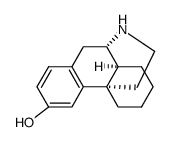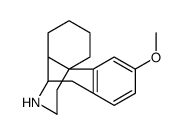Metabolism of dextromethorphan in vitro: involvement of cytochromes P450 2D6 and 3A3/4, with a possible role of 2E1.
J Schmider, D J Greenblatt, S M Fogelman, L L von Moltke, R I Shader
Index: Biopharm. Drug Dispos. 18(3) , 227-40, (1997)
Full Text: HTML
Abstract
Dextromethorphan (DMO), a cough suppressing synthetic analog of codeine, undergoes parallel O-demethylation to dextrorphan (DOP), and N-demethylation to 3-methoxymorphinan (MEM), in humans. 3-hydroxymorphinan, a didemethylated metabolite, is formed secondarily. O-demethylation activity is well established as an index reaction for CYP2D6. However, this pathway appears to be mediated by at least two different enzymes in vitro. N-demethylation activity has recently been proposed to reflect CYP3A3/4 activity. We investigated both pathways in vitro with microsomal preparations from three human livers to assess the value of DMO as a probe drug for CYP2D6 and CYP3A3/4, DMO O-demethylation displayed a biphasic pattern with a high-affinity site reflecting CYP2D6 activity (mean Ki for quinidine, 0.1 +/- 0.13 microM). Kinetic parameters for the two O-demethylation mediating enzymes predict an average relative intrinsic clearance (Vmax/K(m) ratio) of 96% of total O-demethylation mediated via the high-affinity enzyme. Thus, in vitro data confirms the usefulness of DMO O-demethylation as an index reaction to monitor CYP2D6 activity. The Eadie-Hofstee plot of DMO N-demethylation was consistent with single-enzyme Michaelis-Menten kinetics (Vmax varying from 3.3 to 6.8 nmol mg-1 min-1, K(m) from 231 to 322 microM). However, ketoconazole, a CYP3A3/4 inhibitor, reduced N-demethylation only by 60% and had a mean Ki an order of magnitude higher (0.37 microM) compared to other pure CYP3A3/4 mediated reactions. Troleandomycin, a mechanism based CYP3A3/4 inhibitor, inhibited MEM formation by an average maximum of 46%, with an IC50 varying from 1 to 2.6 microM. A polyclonal rat liver CYP3A1 antibody inhibited MEM formation only by approximately 50%. Diethyldithiocarbamate (DDC), a mechanism based CYP2E1 inhibitor, reduced MEM formation at concentrations up to 150 microM between 33 and 43%. Chemical inhibitors of CYP2d6 (quinidine), CYP1A1/2 (alpha-naphthoflavone), and CYP2C9 (sulfaphenazole), as well as a goat rat liver CYP2C11 polyclonal antibody (inhibitory against human CYP2C9 and CYP2C19), had minimal effect on MEM formation rate, thus excluding an involvement of any of these enzymes. DMO N-demethylation is only partly mediated by CYP3A3/4, and therefore is not a reliable index reaction for CYP3A3/4 activity either in vitro or probably in vivo.
Related Compounds
| Structure | Name/CAS No. | Molecular Formula | Articles |
|---|---|---|---|
 |
(+)-3-HYDROXYMORPHINAN HYDROBROMIDE
CAS:15676-23-0 |
C16H21NO | |
 |
Morphinan, 3-methoxy
CAS:1531-25-5 |
C17H23NO |
|
A validated SIM GC/MS method for the simultaneous determinat...
2009-11-01 [Biomed. Chromatogr. 23(11) , 1131-7, (2009)] |
|
Simultaneous quantification of dextromethorphan and its meta...
2011-01-25 [J. Pharm. Biomed. Anal. 54(2) , 387-94, (2011)] |
|
Validation of a liquid chromatography-mass spectrometry meth...
2005-05-05 [J. Chromatogr. B. Analyt. Technol. Biomed. Life Sci. 819(1) , 105-13, (2005)] |
|
New morphinan derivatives with negligible psychotropic effec...
2003-03-07 [Life Sci. 72(16) , 1883-95, (2003)] |
|
Metabolism of dextrorphan by CYP2D6 in different recombinant...
2009-02-01 [J. Pharm. Sci. 98(2) , 763-71, (2009)] |